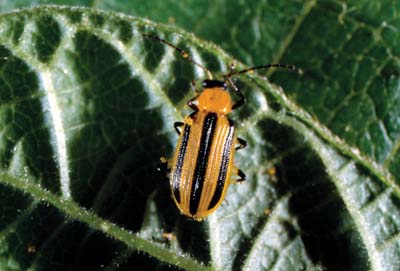Striped Cucumber Beetle, Acalymma vittatum
(Coleoptera: Chrysomelidae)
The striped cucumber beetle is found throughout the United States and is an important pest of cucurbits in the midwestern and northeastern states, though less common in Florida. A generation can be completed in 40 to 60 days and is highly dependent on the prevailing weather patterns. Eggs are round and yellow. The larvae are white and have a dark head capsule. Pupation occurs in the soil, and the pupa resembles the adult but has poorly developed wings. The adult is yellow with three black stripes on each wing cover, with a yellow thorax, and a distinct black head. Adults are the overwintering stage and may be found in organic debris or in the soil.
Host plants that are commonly attacked are in the families Cucurbitacae, Rosaceae, Leguminosae, and Compositae. Crop injury is usually confined to cucurbit crops. Alternate hosts become important in the autumn when cucurbit crops have declined. Damage is caused directly by feeding and indirectly through the transmission of plant diseases. Adults normally feed on aboveground parts of the plant while larvae normally feed on below ground parts. Diseases that are vectored by the striped cucumber beetle include Fusarium wilt and bacterial wilt. Insecticides are commonly used to control striped cucumber beetle. Liquid foliar protectants are commonly applied to young plants, and granular formulations may be applied over the plant row to protect roots from larval tunneling. Pollinators should be taken into consideration before insecticides are applied. Cultural control practices include late planting, row covers, resistant cultivars, and trap crops. Biological control of rootworm larvae may be attained with the use of steinernematid and heterorhabditid nematodes that can be applied through trickle irrigation emitters.
Images
To save the Web-optimized images shown below to your hard drive:
PC users: right click to "Save Picture (or Image) As..."
Mac users: click and drag to your desktop.
Copyright © 2005 University of Florida
